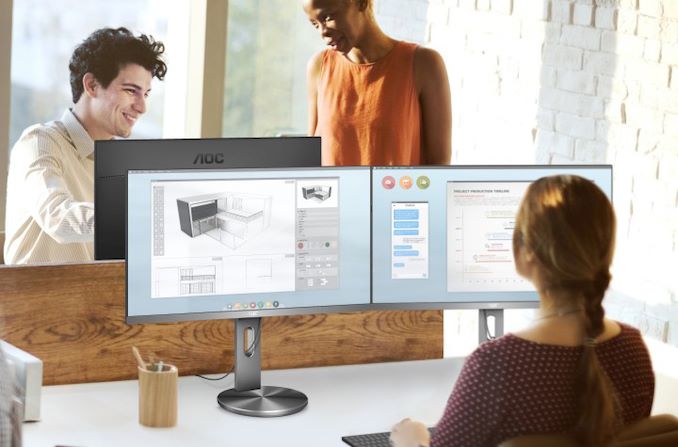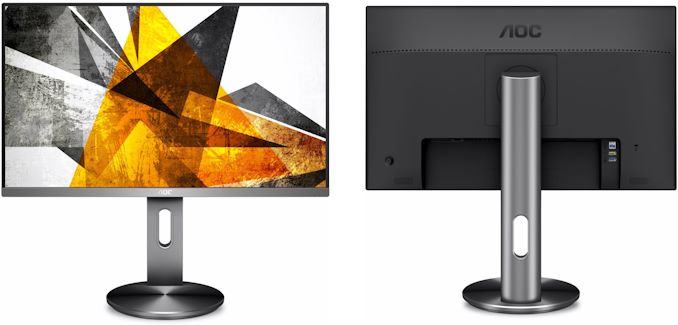AOC's Professional U2790PQU Monitor: 4K, 10-Bit, IPS, Sub $350
by Anton Shilov on July 2, 2019 11:00 AM EST
AOC is a brand primarily known for its gaming, mainstream, stylish, and entry-level displays. Meanwhile, the company also has its 90-series monitors aimed at demanding professionals, offering color accuracy and other features appreciated by the target audience. Last week the company introduced its most advanced addition to the 90-series lineup: the U2790PQU display that combines a 10-bit 4K panel and a relatively low price.
The AOC U2790PQU monitor is based on a 10-bit 27-inch IPS panel featuring a 3840×2160 resolution, 350 nits brightness, a 1000:1 contrast ratio, 5 ms response time, 60 Hz refresh rate, and 178/178º viewing angles. For some reason, AOC does not disclose anything about the color gamuts the display supports, but indicates that the LCD supports the company’s Wide Color Gamut technology, which might mean that we are dealing with a monitor that supports wider than 100% sRGB color gamut, but this is only a suggestion.
Two important features of the AOC U2790PQU display are their very thin bezels along with an adjustable stand. The former will enable owners to organize multi-monitor setups easier.
When it comes to connectivity, the AOC U2790PQU has one DisplayPort 1.2, an HDMI 2.0, and one HDMI 1.4 input. In addition, the monitor has integrated speakers, a headphone out, and a dual-port USB 3.0 hub.
| Brief Specifications of the AOC's U2790PQU | ||
| Panel | 27" IPS | |
| Resolution | 3840 × 2160 | |
| Refresh Rate | 60 Hz | |
| Response Time | 5 ms gray-to-gray | |
| Brightness | Normal: 350 cd/m² | |
| Contrast | 1000:1 | |
| Viewing Angles | 178°/178° horizontal/vertical | |
| Color Saturation | ? | |
| Display Colors | 1.07 billion | |
| 3D-LUT | ? bits | |
| Pixel Pitch | 0.1554 mm² | |
| Pixel Density | 163 PPI | |
| Anti-Glare Coating | ? | |
| Inputs | 1 × DP 1.2 1 × HDMI 2.0 1 × HDMI 1.4 |
|
| USB Hub | dual-port USB 3.0 hub | |
| Audio | 2 × 2 W speakers 3.5-mm mini jack |
|
| Mechanical Design | Chassis Colors: black, metallic. Tilt: yes Height Adjustment: yes Swivel: yes |
|
| Power Consumption | Idle | 0.5 W |
| Active | 35 W | |
AOC will start selling the monitor in July for £299 in the UK. Pricing in the US is unknown, yet it is likely that its MSRP will be around $315.
Related Reading:
- AOC Agon 35-Inch 200 Hz Curved 3440x1440 HDR Gaming Monitor with FreeSync 2 or GSync
- AOC Introduces Its G2868PQU Monitor: An Inexpensive 4K Gaming Display with FreeSync
- AOC’s Entry-Level C2789FH8 27” Display Weds Gold, Bling, and Curvature
- AOC Teams Up with Porsche Design for PDS241 and PDS271 Displays
Source: AOC











40 Comments
View All Comments
Spunjji - Wednesday, July 3, 2019 - link
I found 150% or 175% scaling to work best for me with the display same size and resolution. Using it at 100% is an impressive feat, but probably not practical for the majority of people.My work monitor is 24" 2560x1440 and I use that at 100% scaling. The vast majority of my colleagues set it to 150%, though.
FullmetalTitan - Wednesday, July 3, 2019 - link
How? I have slightly better than 20/20 (thanks lasers) and I still need at least 125% scaling on a 27" to avoid eye strain. Personally I think the ideal 4K screen size for desk use is closer to 32", and wish that were the most common panel sizeJoeyJoJo123 - Tuesday, July 9, 2019 - link
How? I dunno. Maybe the general UI elements don't need to be so large to use dynamically sized content?Like, here's the thing, why would I need to use windows display scaling at non-integer scales to make everything look fuzzy/bad? That bothers me a lot more than smaller UI elements.
What are the benefits to smaller UI elements?
More tabs are shown along the top bad of a browser.
Less vertical real estate taken up by a URL bar or the start bar. (Note: I used the minimal size Start bar icons on a 24" 1080p display before this, now I just use the standard size on a 24" 4K and it's about the same size)
Smaller X icon makes it less accidental to close windows by accident.
As far as webcontent, it's like less than a second to CTRL + Scrollwheel up to fit the content onto the browser so that there's less wasted whitespace. Web browser remembers your scaling size for that website on the future. Generally, 125% to 150% is fine for a web browser docked to 1 half of the display. Sometimes, some archaic websites you need to do 175% or 200% normal size for it to look right. Good websites you don't even need to touch since they dynamically size whether on a mobile display or on a large 4k.
Video games? Just turn off AA (4k at 24" is effectively such a dense resolution that the difference betwee AA and no AA is nigh imperceptible, but you CAN tell a huge difference in framerate) and low to mid shadows and turn off the nasty gunk like motion blur or awful blinding lighting effects like adaptive exposure. Still runs 60fps+ on modern titles. Most content on videogames scale just fine, even menus. Sometimes chat box might be small, but people are usually posting garbage on global chat so I disable it if possible anyways.
Honestly, it's not a question of "how do you see that stuff, it's so small" but moreso I don't need large UI elements to do what I need to do on my PC. And even then, most content just scales the actual content you're doing just fine to the display. Like, consider a Word document on a 1080p vs 4k screen. The document you're typing into is still the same size, it's just the ribbon buttons along the top are less in the way.
JoeyJoJo123 - Tuesday, July 9, 2019 - link
Also, technically, I fail sight tests on my right eye, but my left eye is fine, but probably not 20/20.The only thing Windows display scaling does is adjust UI element sizing which I don't care for. It's a big misunderstanding when people think high DPI monitors are only usable if you increase display scaling. You don't really need to, even on a 4k 24".
Spunjji - Wednesday, July 3, 2019 - link
Personally I prefer the way things look on a high PPI display. I'm perfectly happy with the *size* of the display, I just want the elements occupying that space to be more detailed. I suspect this speaks to a difference in the tasks we use our monitors for.Dug - Tuesday, July 2, 2019 - link
Absolutely agree. 4k on 27" is not ideal for content creation and editing. 32" is really a benefit at 4k.Midwayman - Tuesday, July 2, 2019 - link
Honestly those monitors get too tall to be really useful. I'd rather have a curved ultrawide when it gets bigger than 27" in 16:9. I get the pixel density, but scanning up and down is distracting.imaheadcase - Tuesday, July 2, 2019 - link
You shouldn't be scanned up and down at all, you are sitting to close.akvadrako - Tuesday, July 2, 2019 - link
27" is perfect for 200% scaling with 4K, though 5K would be fine too. For me, 4K @ 32" means either non-integer scaling or UI elements are too large.rmm584 - Tuesday, July 2, 2019 - link
Have none of you used 4k on a 27 inch monitor? While 4k on 27 inch screen is good, I would say that 5k is the ideal resolution at that 27 inches. This is from using both the 5k imac and a 4k 27 screen for quite some time.